Food Safety Management Report: Wagamama Restaurant and Food Safety
VerifiedAdded on 2020/10/05
|11
|3363
|269
Report
AI Summary
This report delves into the critical aspects of food safety management, focusing on the prevention of foodborne illnesses within the hospitality industry, using Wagamama Restaurant as a case study. It begins by categorizing food spoilage agents and evaluating various food preservation methods, such as drying, canning, freezing, and vacuum packing, assessing their effectiveness. The report then outlines key steps in temperature control systems and explores safe food storage methods, emphasizing the importance of personal hygiene, cleaning, and disinfection in maintaining safe food production. Furthermore, it addresses pest control challenges in food premises and the need for hygienic design and construction. The report concludes with a discussion of food hazard risk assessment, food safety control systems, and compliance with food safety legislation, providing a comprehensive overview of best practices in food safety management.
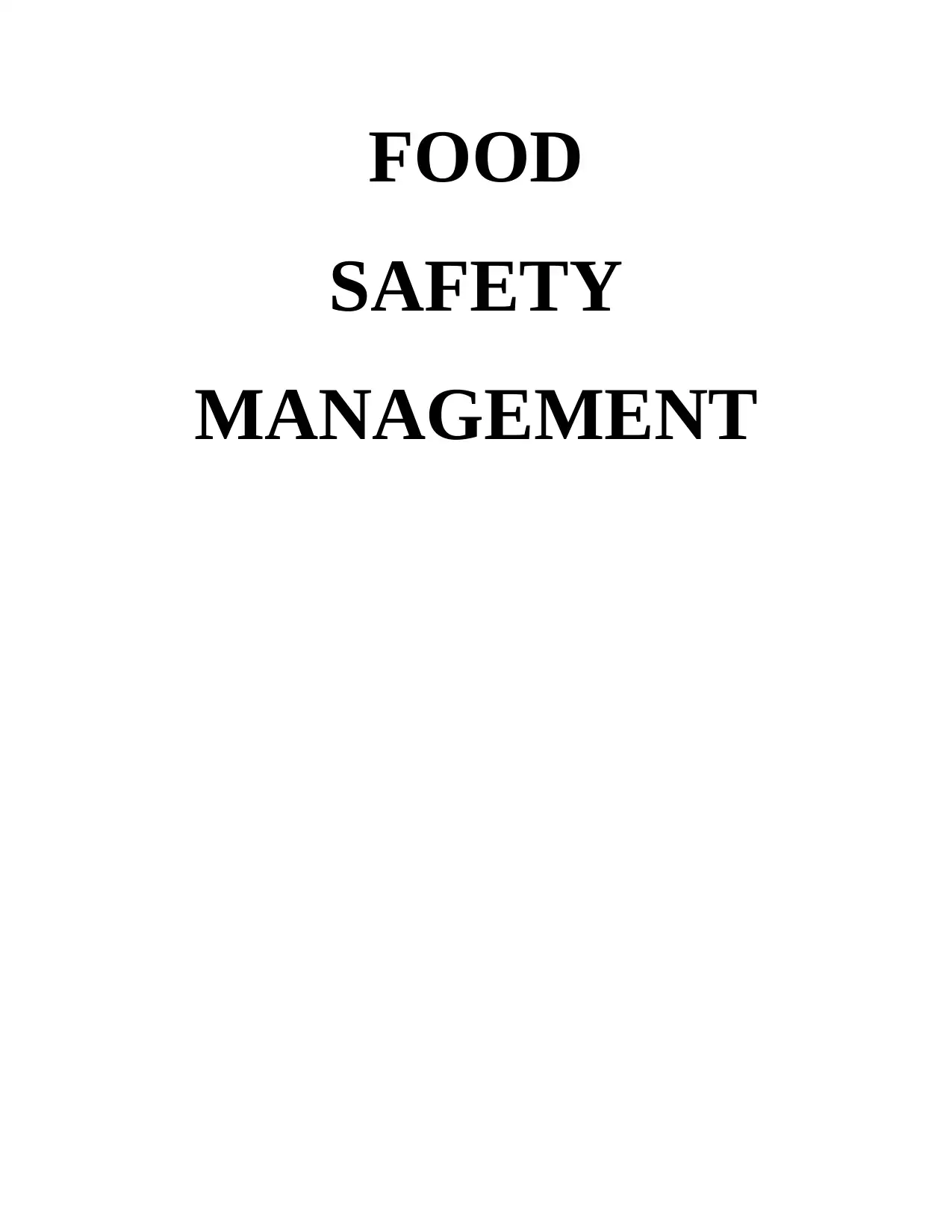
FOOD
SAFETY
MANAGEMENT
SAFETY
MANAGEMENT
Paraphrase This Document
Need a fresh take? Get an instant paraphrase of this document with our AI Paraphraser
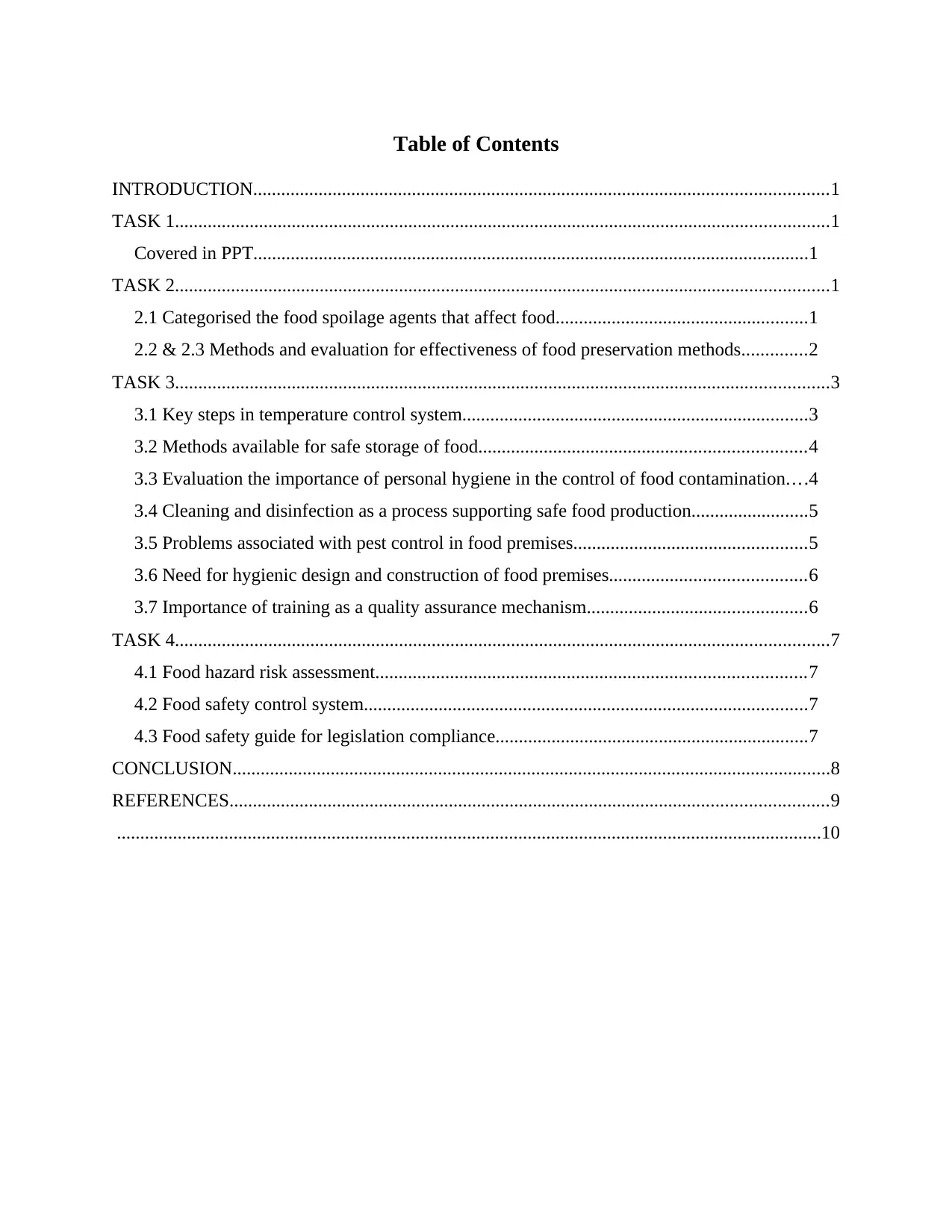
Table of Contents
INTRODUCTION...........................................................................................................................1
TASK 1............................................................................................................................................1
Covered in PPT.......................................................................................................................1
TASK 2............................................................................................................................................1
2.1 Categorised the food spoilage agents that affect food......................................................1
2.2 & 2.3 Methods and evaluation for effectiveness of food preservation methods..............2
TASK 3............................................................................................................................................3
3.1 Key steps in temperature control system..........................................................................3
3.2 Methods available for safe storage of food......................................................................4
3.3 Evaluation the importance of personal hygiene in the control of food contamination....4
3.4 Cleaning and disinfection as a process supporting safe food production.........................5
3.5 Problems associated with pest control in food premises..................................................5
3.6 Need for hygienic design and construction of food premises..........................................6
3.7 Importance of training as a quality assurance mechanism...............................................6
TASK 4............................................................................................................................................7
4.1 Food hazard risk assessment............................................................................................7
4.2 Food safety control system...............................................................................................7
4.3 Food safety guide for legislation compliance...................................................................7
CONCLUSION................................................................................................................................8
REFERENCES................................................................................................................................9
.......................................................................................................................................................10
INTRODUCTION...........................................................................................................................1
TASK 1............................................................................................................................................1
Covered in PPT.......................................................................................................................1
TASK 2............................................................................................................................................1
2.1 Categorised the food spoilage agents that affect food......................................................1
2.2 & 2.3 Methods and evaluation for effectiveness of food preservation methods..............2
TASK 3............................................................................................................................................3
3.1 Key steps in temperature control system..........................................................................3
3.2 Methods available for safe storage of food......................................................................4
3.3 Evaluation the importance of personal hygiene in the control of food contamination....4
3.4 Cleaning and disinfection as a process supporting safe food production.........................5
3.5 Problems associated with pest control in food premises..................................................5
3.6 Need for hygienic design and construction of food premises..........................................6
3.7 Importance of training as a quality assurance mechanism...............................................6
TASK 4............................................................................................................................................7
4.1 Food hazard risk assessment............................................................................................7
4.2 Food safety control system...............................................................................................7
4.3 Food safety guide for legislation compliance...................................................................7
CONCLUSION................................................................................................................................8
REFERENCES................................................................................................................................9
.......................................................................................................................................................10
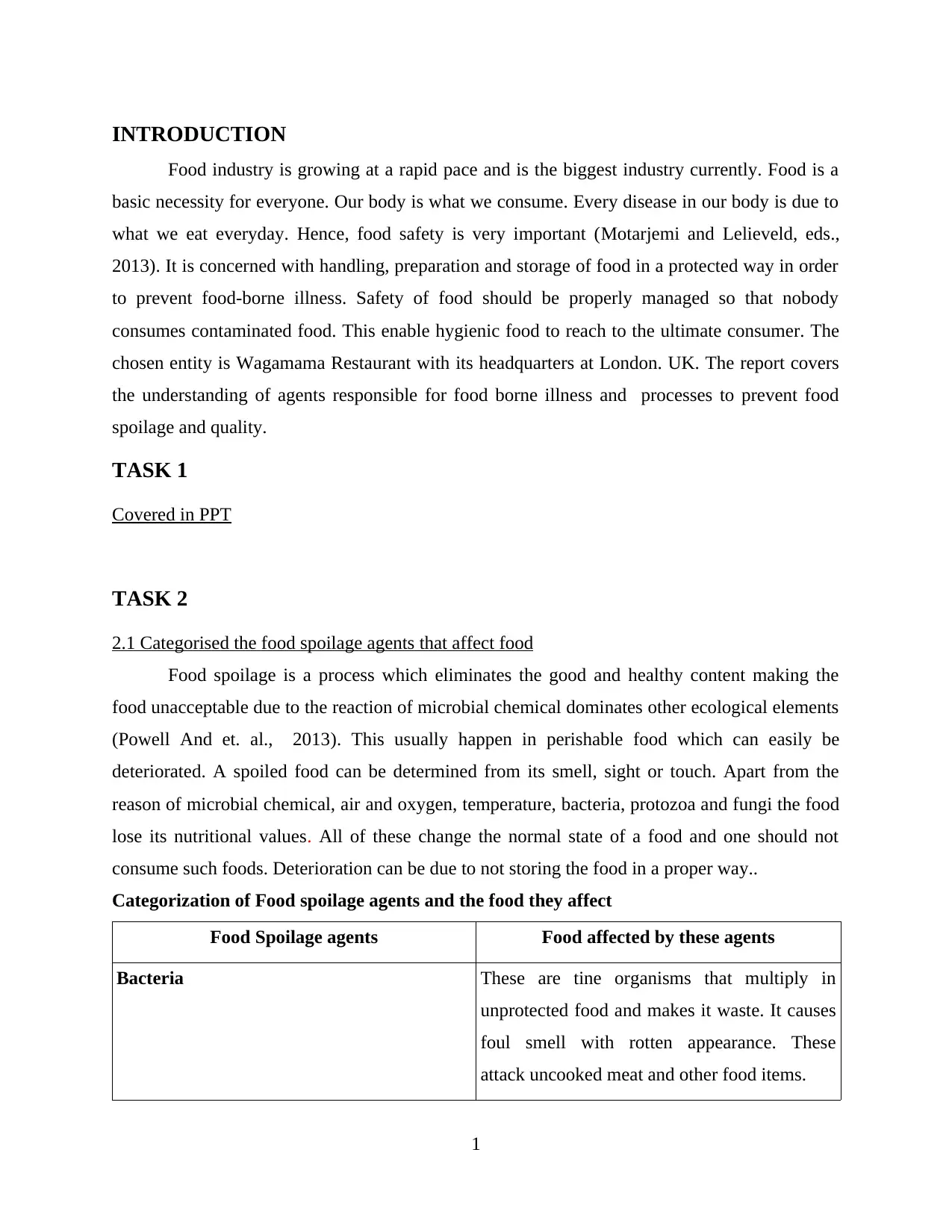
INTRODUCTION
Food industry is growing at a rapid pace and is the biggest industry currently. Food is a
basic necessity for everyone. Our body is what we consume. Every disease in our body is due to
what we eat everyday. Hence, food safety is very important (Motarjemi and Lelieveld, eds.,
2013). It is concerned with handling, preparation and storage of food in a protected way in order
to prevent food-borne illness. Safety of food should be properly managed so that nobody
consumes contaminated food. This enable hygienic food to reach to the ultimate consumer. The
chosen entity is Wagamama Restaurant with its headquarters at London. UK. The report covers
the understanding of agents responsible for food borne illness and processes to prevent food
spoilage and quality.
TASK 1
Covered in PPT
TASK 2
2.1 Categorised the food spoilage agents that affect food
Food spoilage is a process which eliminates the good and healthy content making the
food unacceptable due to the reaction of microbial chemical dominates other ecological elements
(Powell And et. al., 2013). This usually happen in perishable food which can easily be
deteriorated. A spoiled food can be determined from its smell, sight or touch. Apart from the
reason of microbial chemical, air and oxygen, temperature, bacteria, protozoa and fungi the food
lose its nutritional values. All of these change the normal state of a food and one should not
consume such foods. Deterioration can be due to not storing the food in a proper way..
Categorization of Food spoilage agents and the food they affect
Food Spoilage agents Food affected by these agents
Bacteria These are tine organisms that multiply in
unprotected food and makes it waste. It causes
foul smell with rotten appearance. These
attack uncooked meat and other food items.
1
Food industry is growing at a rapid pace and is the biggest industry currently. Food is a
basic necessity for everyone. Our body is what we consume. Every disease in our body is due to
what we eat everyday. Hence, food safety is very important (Motarjemi and Lelieveld, eds.,
2013). It is concerned with handling, preparation and storage of food in a protected way in order
to prevent food-borne illness. Safety of food should be properly managed so that nobody
consumes contaminated food. This enable hygienic food to reach to the ultimate consumer. The
chosen entity is Wagamama Restaurant with its headquarters at London. UK. The report covers
the understanding of agents responsible for food borne illness and processes to prevent food
spoilage and quality.
TASK 1
Covered in PPT
TASK 2
2.1 Categorised the food spoilage agents that affect food
Food spoilage is a process which eliminates the good and healthy content making the
food unacceptable due to the reaction of microbial chemical dominates other ecological elements
(Powell And et. al., 2013). This usually happen in perishable food which can easily be
deteriorated. A spoiled food can be determined from its smell, sight or touch. Apart from the
reason of microbial chemical, air and oxygen, temperature, bacteria, protozoa and fungi the food
lose its nutritional values. All of these change the normal state of a food and one should not
consume such foods. Deterioration can be due to not storing the food in a proper way..
Categorization of Food spoilage agents and the food they affect
Food Spoilage agents Food affected by these agents
Bacteria These are tine organisms that multiply in
unprotected food and makes it waste. It causes
foul smell with rotten appearance. These
attack uncooked meat and other food items.
1
⊘ This is a preview!⊘
Do you want full access?
Subscribe today to unlock all pages.

Trusted by 1+ million students worldwide
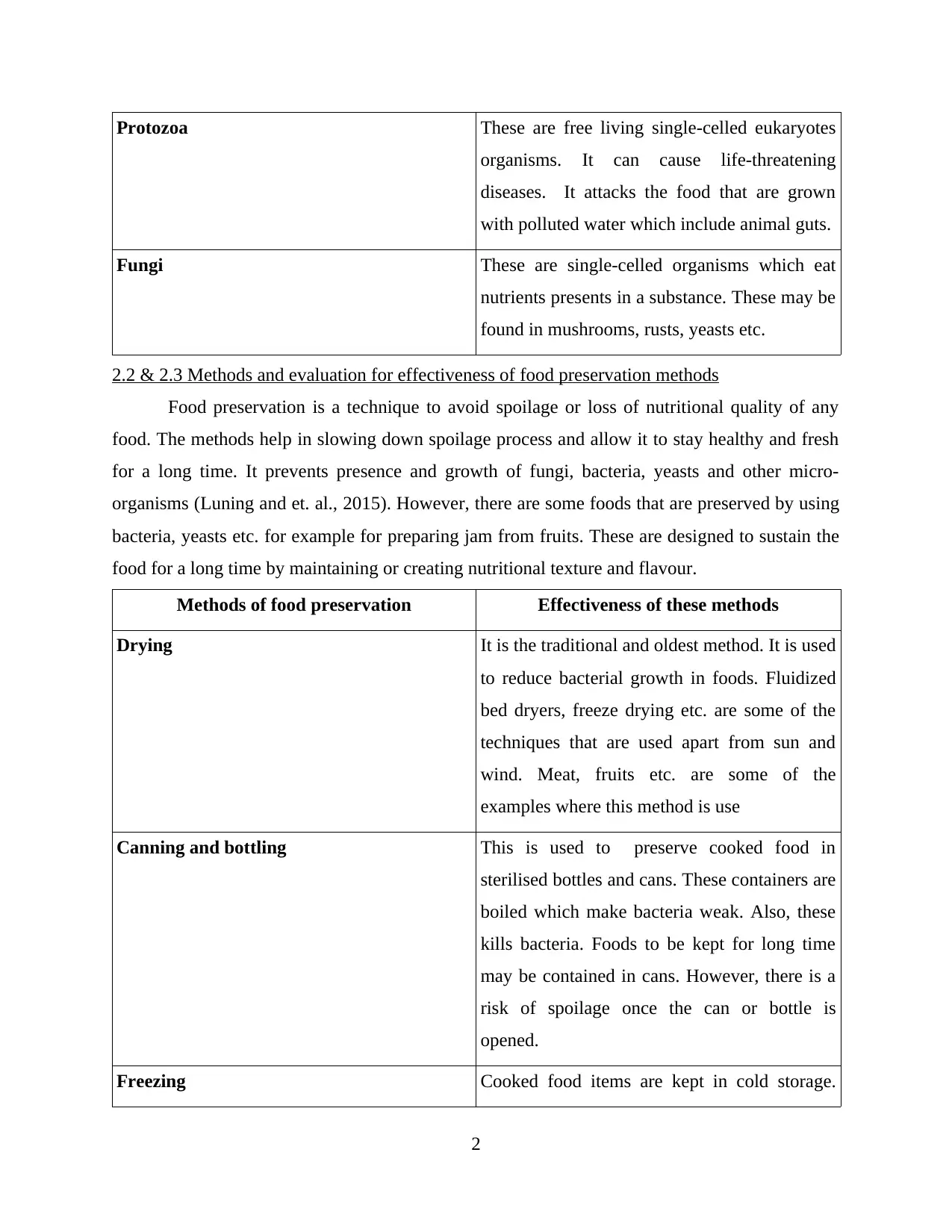
Protozoa These are free living single-celled eukaryotes
organisms. It can cause life-threatening
diseases. It attacks the food that are grown
with polluted water which include animal guts.
Fungi These are single-celled organisms which eat
nutrients presents in a substance. These may be
found in mushrooms, rusts, yeasts etc.
2.2 & 2.3 Methods and evaluation for effectiveness of food preservation methods
Food preservation is a technique to avoid spoilage or loss of nutritional quality of any
food. The methods help in slowing down spoilage process and allow it to stay healthy and fresh
for a long time. It prevents presence and growth of fungi, bacteria, yeasts and other micro-
organisms (Luning and et. al., 2015). However, there are some foods that are preserved by using
bacteria, yeasts etc. for example for preparing jam from fruits. These are designed to sustain the
food for a long time by maintaining or creating nutritional texture and flavour.
Methods of food preservation Effectiveness of these methods
Drying It is the traditional and oldest method. It is used
to reduce bacterial growth in foods. Fluidized
bed dryers, freeze drying etc. are some of the
techniques that are used apart from sun and
wind. Meat, fruits etc. are some of the
examples where this method is use
Canning and bottling This is used to preserve cooked food in
sterilised bottles and cans. These containers are
boiled which make bacteria weak. Also, these
kills bacteria. Foods to be kept for long time
may be contained in cans. However, there is a
risk of spoilage once the can or bottle is
opened.
Freezing Cooked food items are kept in cold storage.
2
organisms. It can cause life-threatening
diseases. It attacks the food that are grown
with polluted water which include animal guts.
Fungi These are single-celled organisms which eat
nutrients presents in a substance. These may be
found in mushrooms, rusts, yeasts etc.
2.2 & 2.3 Methods and evaluation for effectiveness of food preservation methods
Food preservation is a technique to avoid spoilage or loss of nutritional quality of any
food. The methods help in slowing down spoilage process and allow it to stay healthy and fresh
for a long time. It prevents presence and growth of fungi, bacteria, yeasts and other micro-
organisms (Luning and et. al., 2015). However, there are some foods that are preserved by using
bacteria, yeasts etc. for example for preparing jam from fruits. These are designed to sustain the
food for a long time by maintaining or creating nutritional texture and flavour.
Methods of food preservation Effectiveness of these methods
Drying It is the traditional and oldest method. It is used
to reduce bacterial growth in foods. Fluidized
bed dryers, freeze drying etc. are some of the
techniques that are used apart from sun and
wind. Meat, fruits etc. are some of the
examples where this method is use
Canning and bottling This is used to preserve cooked food in
sterilised bottles and cans. These containers are
boiled which make bacteria weak. Also, these
kills bacteria. Foods to be kept for long time
may be contained in cans. However, there is a
risk of spoilage once the can or bottle is
opened.
Freezing Cooked food items are kept in cold storage.
2
Paraphrase This Document
Need a fresh take? Get an instant paraphrase of this document with our AI Paraphraser
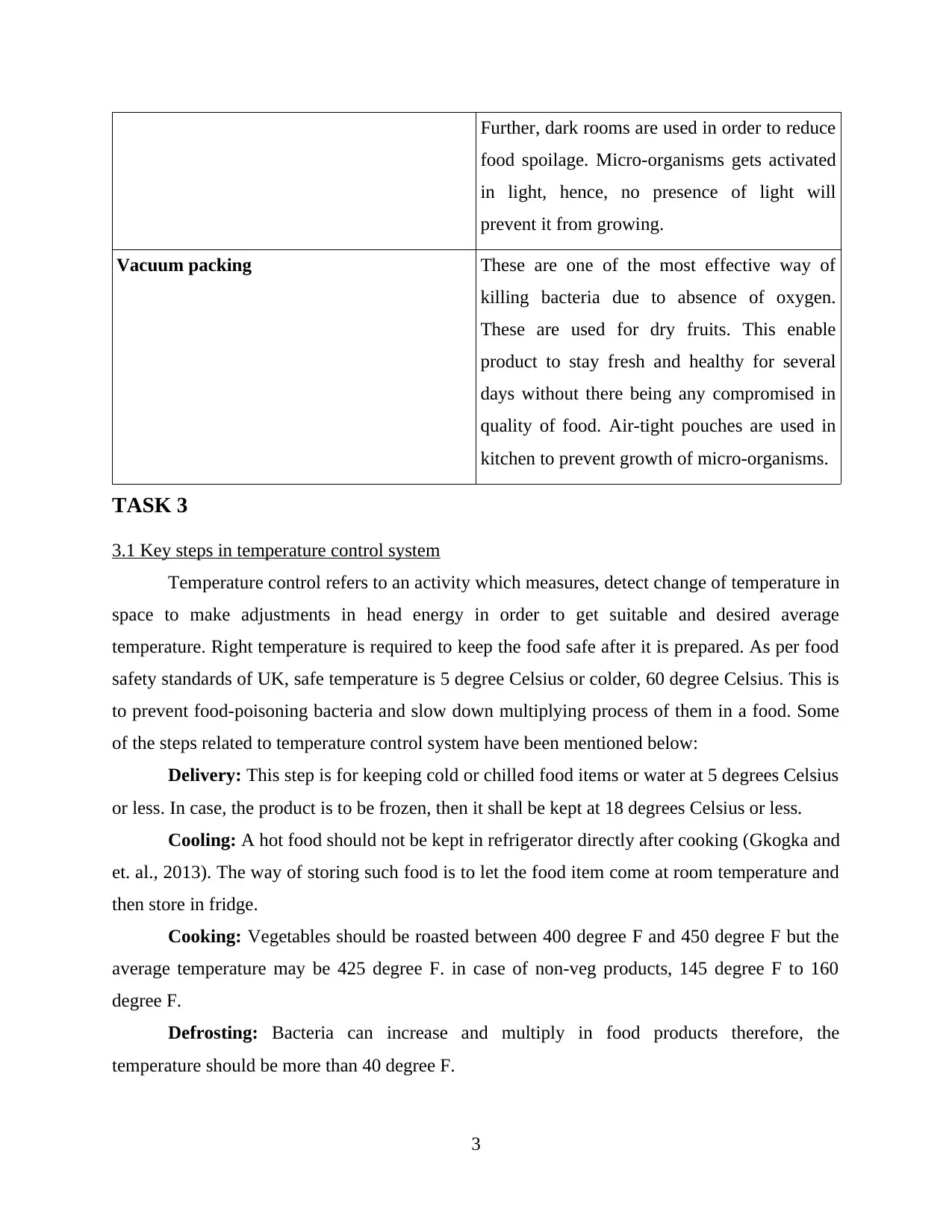
Further, dark rooms are used in order to reduce
food spoilage. Micro-organisms gets activated
in light, hence, no presence of light will
prevent it from growing.
Vacuum packing These are one of the most effective way of
killing bacteria due to absence of oxygen.
These are used for dry fruits. This enable
product to stay fresh and healthy for several
days without there being any compromised in
quality of food. Air-tight pouches are used in
kitchen to prevent growth of micro-organisms.
TASK 3
3.1 Key steps in temperature control system
Temperature control refers to an activity which measures, detect change of temperature in
space to make adjustments in head energy in order to get suitable and desired average
temperature. Right temperature is required to keep the food safe after it is prepared. As per food
safety standards of UK, safe temperature is 5 degree Celsius or colder, 60 degree Celsius. This is
to prevent food-poisoning bacteria and slow down multiplying process of them in a food. Some
of the steps related to temperature control system have been mentioned below:
Delivery: This step is for keeping cold or chilled food items or water at 5 degrees Celsius
or less. In case, the product is to be frozen, then it shall be kept at 18 degrees Celsius or less.
Cooling: A hot food should not be kept in refrigerator directly after cooking (Gkogka and
et. al., 2013). The way of storing such food is to let the food item come at room temperature and
then store in fridge.
Cooking: Vegetables should be roasted between 400 degree F and 450 degree F but the
average temperature may be 425 degree F. in case of non-veg products, 145 degree F to 160
degree F.
Defrosting: Bacteria can increase and multiply in food products therefore, the
temperature should be more than 40 degree F.
3
food spoilage. Micro-organisms gets activated
in light, hence, no presence of light will
prevent it from growing.
Vacuum packing These are one of the most effective way of
killing bacteria due to absence of oxygen.
These are used for dry fruits. This enable
product to stay fresh and healthy for several
days without there being any compromised in
quality of food. Air-tight pouches are used in
kitchen to prevent growth of micro-organisms.
TASK 3
3.1 Key steps in temperature control system
Temperature control refers to an activity which measures, detect change of temperature in
space to make adjustments in head energy in order to get suitable and desired average
temperature. Right temperature is required to keep the food safe after it is prepared. As per food
safety standards of UK, safe temperature is 5 degree Celsius or colder, 60 degree Celsius. This is
to prevent food-poisoning bacteria and slow down multiplying process of them in a food. Some
of the steps related to temperature control system have been mentioned below:
Delivery: This step is for keeping cold or chilled food items or water at 5 degrees Celsius
or less. In case, the product is to be frozen, then it shall be kept at 18 degrees Celsius or less.
Cooling: A hot food should not be kept in refrigerator directly after cooking (Gkogka and
et. al., 2013). The way of storing such food is to let the food item come at room temperature and
then store in fridge.
Cooking: Vegetables should be roasted between 400 degree F and 450 degree F but the
average temperature may be 425 degree F. in case of non-veg products, 145 degree F to 160
degree F.
Defrosting: Bacteria can increase and multiply in food products therefore, the
temperature should be more than 40 degree F.
3
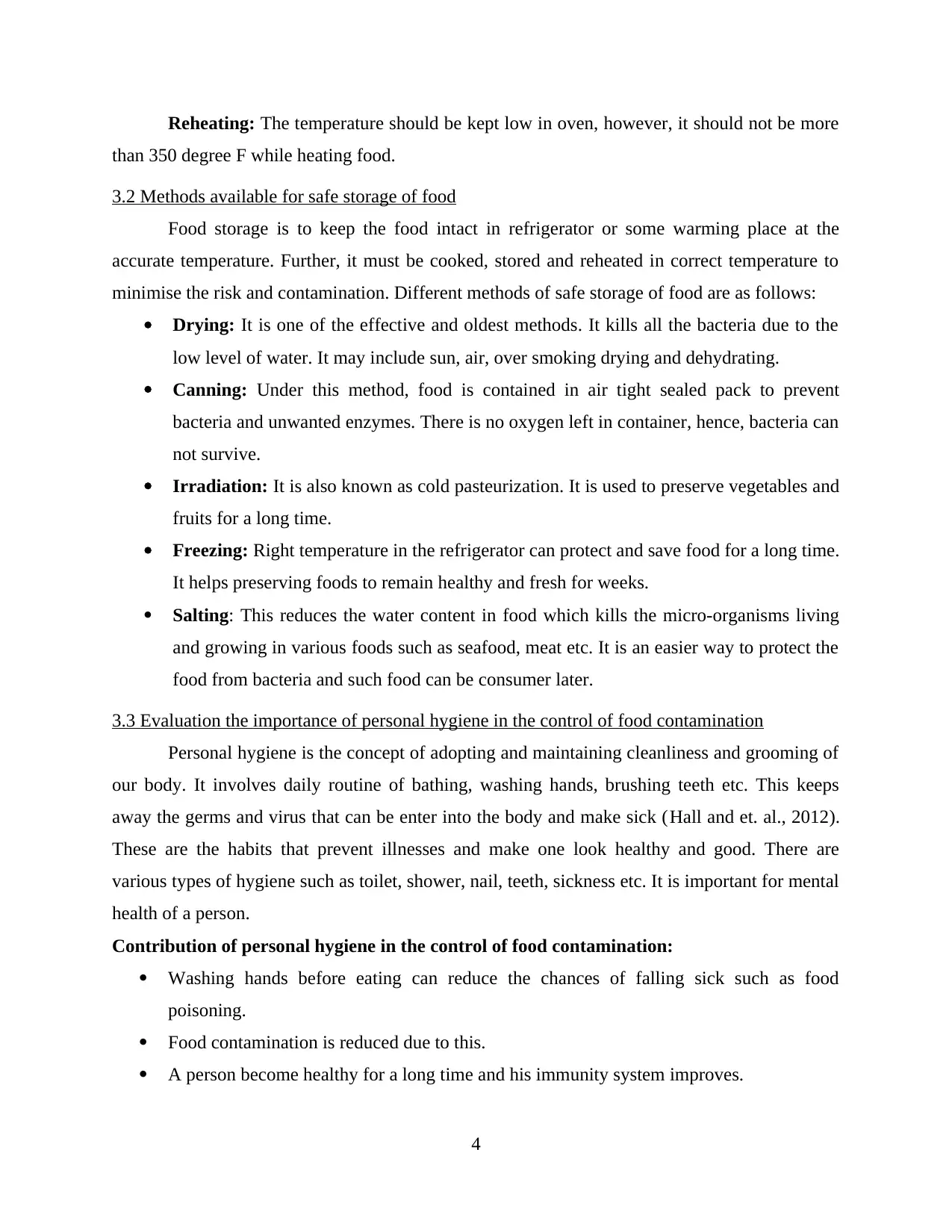
Reheating: The temperature should be kept low in oven, however, it should not be more
than 350 degree F while heating food.
3.2 Methods available for safe storage of food
Food storage is to keep the food intact in refrigerator or some warming place at the
accurate temperature. Further, it must be cooked, stored and reheated in correct temperature to
minimise the risk and contamination. Different methods of safe storage of food are as follows:
Drying: It is one of the effective and oldest methods. It kills all the bacteria due to the
low level of water. It may include sun, air, over smoking drying and dehydrating.
Canning: Under this method, food is contained in air tight sealed pack to prevent
bacteria and unwanted enzymes. There is no oxygen left in container, hence, bacteria can
not survive.
Irradiation: It is also known as cold pasteurization. It is used to preserve vegetables and
fruits for a long time.
Freezing: Right temperature in the refrigerator can protect and save food for a long time.
It helps preserving foods to remain healthy and fresh for weeks.
Salting: This reduces the water content in food which kills the micro-organisms living
and growing in various foods such as seafood, meat etc. It is an easier way to protect the
food from bacteria and such food can be consumer later.
3.3 Evaluation the importance of personal hygiene in the control of food contamination
Personal hygiene is the concept of adopting and maintaining cleanliness and grooming of
our body. It involves daily routine of bathing, washing hands, brushing teeth etc. This keeps
away the germs and virus that can be enter into the body and make sick (Hall and et. al., 2012).
These are the habits that prevent illnesses and make one look healthy and good. There are
various types of hygiene such as toilet, shower, nail, teeth, sickness etc. It is important for mental
health of a person.
Contribution of personal hygiene in the control of food contamination:
Washing hands before eating can reduce the chances of falling sick such as food
poisoning.
Food contamination is reduced due to this.
A person become healthy for a long time and his immunity system improves.
4
than 350 degree F while heating food.
3.2 Methods available for safe storage of food
Food storage is to keep the food intact in refrigerator or some warming place at the
accurate temperature. Further, it must be cooked, stored and reheated in correct temperature to
minimise the risk and contamination. Different methods of safe storage of food are as follows:
Drying: It is one of the effective and oldest methods. It kills all the bacteria due to the
low level of water. It may include sun, air, over smoking drying and dehydrating.
Canning: Under this method, food is contained in air tight sealed pack to prevent
bacteria and unwanted enzymes. There is no oxygen left in container, hence, bacteria can
not survive.
Irradiation: It is also known as cold pasteurization. It is used to preserve vegetables and
fruits for a long time.
Freezing: Right temperature in the refrigerator can protect and save food for a long time.
It helps preserving foods to remain healthy and fresh for weeks.
Salting: This reduces the water content in food which kills the micro-organisms living
and growing in various foods such as seafood, meat etc. It is an easier way to protect the
food from bacteria and such food can be consumer later.
3.3 Evaluation the importance of personal hygiene in the control of food contamination
Personal hygiene is the concept of adopting and maintaining cleanliness and grooming of
our body. It involves daily routine of bathing, washing hands, brushing teeth etc. This keeps
away the germs and virus that can be enter into the body and make sick (Hall and et. al., 2012).
These are the habits that prevent illnesses and make one look healthy and good. There are
various types of hygiene such as toilet, shower, nail, teeth, sickness etc. It is important for mental
health of a person.
Contribution of personal hygiene in the control of food contamination:
Washing hands before eating can reduce the chances of falling sick such as food
poisoning.
Food contamination is reduced due to this.
A person become healthy for a long time and his immunity system improves.
4
⊘ This is a preview!⊘
Do you want full access?
Subscribe today to unlock all pages.

Trusted by 1+ million students worldwide
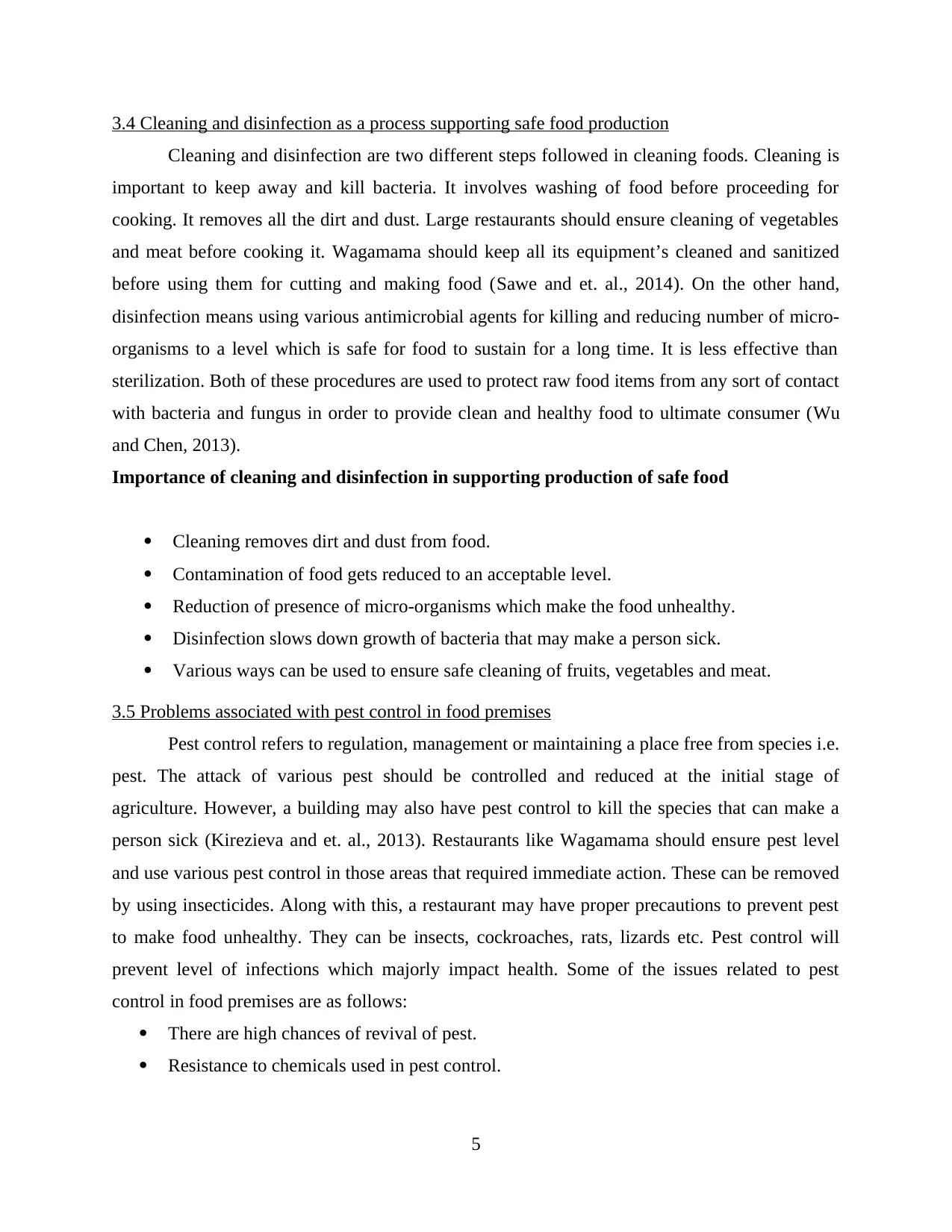
3.4 Cleaning and disinfection as a process supporting safe food production
Cleaning and disinfection are two different steps followed in cleaning foods. Cleaning is
important to keep away and kill bacteria. It involves washing of food before proceeding for
cooking. It removes all the dirt and dust. Large restaurants should ensure cleaning of vegetables
and meat before cooking it. Wagamama should keep all its equipment’s cleaned and sanitized
before using them for cutting and making food (Sawe and et. al., 2014). On the other hand,
disinfection means using various antimicrobial agents for killing and reducing number of micro-
organisms to a level which is safe for food to sustain for a long time. It is less effective than
sterilization. Both of these procedures are used to protect raw food items from any sort of contact
with bacteria and fungus in order to provide clean and healthy food to ultimate consumer (Wu
and Chen, 2013).
Importance of cleaning and disinfection in supporting production of safe food
Cleaning removes dirt and dust from food.
Contamination of food gets reduced to an acceptable level.
Reduction of presence of micro-organisms which make the food unhealthy.
Disinfection slows down growth of bacteria that may make a person sick.
Various ways can be used to ensure safe cleaning of fruits, vegetables and meat.
3.5 Problems associated with pest control in food premises
Pest control refers to regulation, management or maintaining a place free from species i.e.
pest. The attack of various pest should be controlled and reduced at the initial stage of
agriculture. However, a building may also have pest control to kill the species that can make a
person sick (Kirezieva and et. al., 2013). Restaurants like Wagamama should ensure pest level
and use various pest control in those areas that required immediate action. These can be removed
by using insecticides. Along with this, a restaurant may have proper precautions to prevent pest
to make food unhealthy. They can be insects, cockroaches, rats, lizards etc. Pest control will
prevent level of infections which majorly impact health. Some of the issues related to pest
control in food premises are as follows:
There are high chances of revival of pest.
Resistance to chemicals used in pest control.
5
Cleaning and disinfection are two different steps followed in cleaning foods. Cleaning is
important to keep away and kill bacteria. It involves washing of food before proceeding for
cooking. It removes all the dirt and dust. Large restaurants should ensure cleaning of vegetables
and meat before cooking it. Wagamama should keep all its equipment’s cleaned and sanitized
before using them for cutting and making food (Sawe and et. al., 2014). On the other hand,
disinfection means using various antimicrobial agents for killing and reducing number of micro-
organisms to a level which is safe for food to sustain for a long time. It is less effective than
sterilization. Both of these procedures are used to protect raw food items from any sort of contact
with bacteria and fungus in order to provide clean and healthy food to ultimate consumer (Wu
and Chen, 2013).
Importance of cleaning and disinfection in supporting production of safe food
Cleaning removes dirt and dust from food.
Contamination of food gets reduced to an acceptable level.
Reduction of presence of micro-organisms which make the food unhealthy.
Disinfection slows down growth of bacteria that may make a person sick.
Various ways can be used to ensure safe cleaning of fruits, vegetables and meat.
3.5 Problems associated with pest control in food premises
Pest control refers to regulation, management or maintaining a place free from species i.e.
pest. The attack of various pest should be controlled and reduced at the initial stage of
agriculture. However, a building may also have pest control to kill the species that can make a
person sick (Kirezieva and et. al., 2013). Restaurants like Wagamama should ensure pest level
and use various pest control in those areas that required immediate action. These can be removed
by using insecticides. Along with this, a restaurant may have proper precautions to prevent pest
to make food unhealthy. They can be insects, cockroaches, rats, lizards etc. Pest control will
prevent level of infections which majorly impact health. Some of the issues related to pest
control in food premises are as follows:
There are high chances of revival of pest.
Resistance to chemicals used in pest control.
5
Paraphrase This Document
Need a fresh take? Get an instant paraphrase of this document with our AI Paraphraser
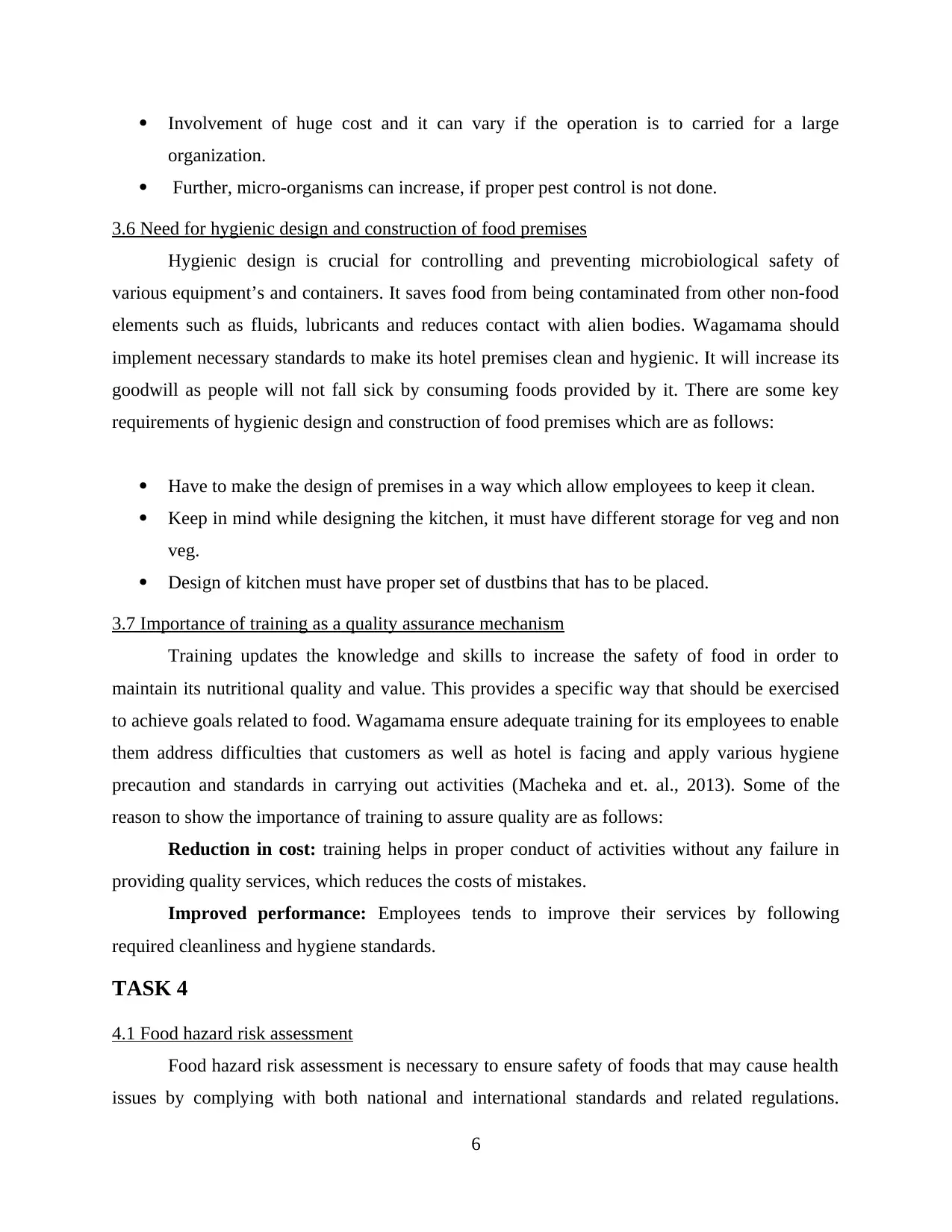
Involvement of huge cost and it can vary if the operation is to carried for a large
organization.
Further, micro-organisms can increase, if proper pest control is not done.
3.6 Need for hygienic design and construction of food premises
Hygienic design is crucial for controlling and preventing microbiological safety of
various equipment’s and containers. It saves food from being contaminated from other non-food
elements such as fluids, lubricants and reduces contact with alien bodies. Wagamama should
implement necessary standards to make its hotel premises clean and hygienic. It will increase its
goodwill as people will not fall sick by consuming foods provided by it. There are some key
requirements of hygienic design and construction of food premises which are as follows:
Have to make the design of premises in a way which allow employees to keep it clean.
Keep in mind while designing the kitchen, it must have different storage for veg and non
veg.
Design of kitchen must have proper set of dustbins that has to be placed.
3.7 Importance of training as a quality assurance mechanism
Training updates the knowledge and skills to increase the safety of food in order to
maintain its nutritional quality and value. This provides a specific way that should be exercised
to achieve goals related to food. Wagamama ensure adequate training for its employees to enable
them address difficulties that customers as well as hotel is facing and apply various hygiene
precaution and standards in carrying out activities (Macheka and et. al., 2013). Some of the
reason to show the importance of training to assure quality are as follows:
Reduction in cost: training helps in proper conduct of activities without any failure in
providing quality services, which reduces the costs of mistakes.
Improved performance: Employees tends to improve their services by following
required cleanliness and hygiene standards.
TASK 4
4.1 Food hazard risk assessment
Food hazard risk assessment is necessary to ensure safety of foods that may cause health
issues by complying with both national and international standards and related regulations.
6
organization.
Further, micro-organisms can increase, if proper pest control is not done.
3.6 Need for hygienic design and construction of food premises
Hygienic design is crucial for controlling and preventing microbiological safety of
various equipment’s and containers. It saves food from being contaminated from other non-food
elements such as fluids, lubricants and reduces contact with alien bodies. Wagamama should
implement necessary standards to make its hotel premises clean and hygienic. It will increase its
goodwill as people will not fall sick by consuming foods provided by it. There are some key
requirements of hygienic design and construction of food premises which are as follows:
Have to make the design of premises in a way which allow employees to keep it clean.
Keep in mind while designing the kitchen, it must have different storage for veg and non
veg.
Design of kitchen must have proper set of dustbins that has to be placed.
3.7 Importance of training as a quality assurance mechanism
Training updates the knowledge and skills to increase the safety of food in order to
maintain its nutritional quality and value. This provides a specific way that should be exercised
to achieve goals related to food. Wagamama ensure adequate training for its employees to enable
them address difficulties that customers as well as hotel is facing and apply various hygiene
precaution and standards in carrying out activities (Macheka and et. al., 2013). Some of the
reason to show the importance of training to assure quality are as follows:
Reduction in cost: training helps in proper conduct of activities without any failure in
providing quality services, which reduces the costs of mistakes.
Improved performance: Employees tends to improve their services by following
required cleanliness and hygiene standards.
TASK 4
4.1 Food hazard risk assessment
Food hazard risk assessment is necessary to ensure safety of foods that may cause health
issues by complying with both national and international standards and related regulations.
6
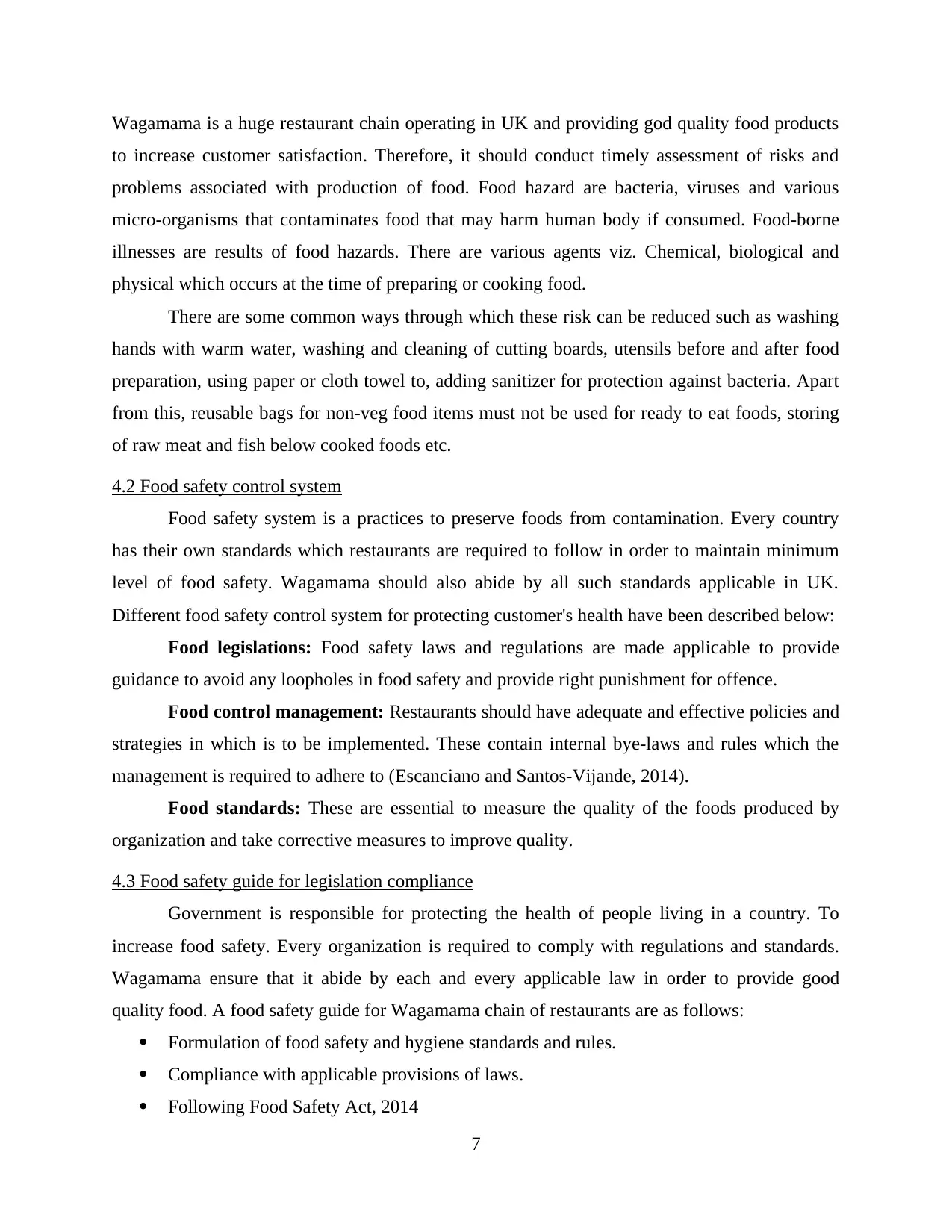
Wagamama is a huge restaurant chain operating in UK and providing god quality food products
to increase customer satisfaction. Therefore, it should conduct timely assessment of risks and
problems associated with production of food. Food hazard are bacteria, viruses and various
micro-organisms that contaminates food that may harm human body if consumed. Food-borne
illnesses are results of food hazards. There are various agents viz. Chemical, biological and
physical which occurs at the time of preparing or cooking food.
There are some common ways through which these risk can be reduced such as washing
hands with warm water, washing and cleaning of cutting boards, utensils before and after food
preparation, using paper or cloth towel to, adding sanitizer for protection against bacteria. Apart
from this, reusable bags for non-veg food items must not be used for ready to eat foods, storing
of raw meat and fish below cooked foods etc.
4.2 Food safety control system
Food safety system is a practices to preserve foods from contamination. Every country
has their own standards which restaurants are required to follow in order to maintain minimum
level of food safety. Wagamama should also abide by all such standards applicable in UK.
Different food safety control system for protecting customer's health have been described below:
Food legislations: Food safety laws and regulations are made applicable to provide
guidance to avoid any loopholes in food safety and provide right punishment for offence.
Food control management: Restaurants should have adequate and effective policies and
strategies in which is to be implemented. These contain internal bye-laws and rules which the
management is required to adhere to (Escanciano and Santos-Vijande, 2014).
Food standards: These are essential to measure the quality of the foods produced by
organization and take corrective measures to improve quality.
4.3 Food safety guide for legislation compliance
Government is responsible for protecting the health of people living in a country. To
increase food safety. Every organization is required to comply with regulations and standards.
Wagamama ensure that it abide by each and every applicable law in order to provide good
quality food. A food safety guide for Wagamama chain of restaurants are as follows:
Formulation of food safety and hygiene standards and rules.
Compliance with applicable provisions of laws.
Following Food Safety Act, 2014
7
to increase customer satisfaction. Therefore, it should conduct timely assessment of risks and
problems associated with production of food. Food hazard are bacteria, viruses and various
micro-organisms that contaminates food that may harm human body if consumed. Food-borne
illnesses are results of food hazards. There are various agents viz. Chemical, biological and
physical which occurs at the time of preparing or cooking food.
There are some common ways through which these risk can be reduced such as washing
hands with warm water, washing and cleaning of cutting boards, utensils before and after food
preparation, using paper or cloth towel to, adding sanitizer for protection against bacteria. Apart
from this, reusable bags for non-veg food items must not be used for ready to eat foods, storing
of raw meat and fish below cooked foods etc.
4.2 Food safety control system
Food safety system is a practices to preserve foods from contamination. Every country
has their own standards which restaurants are required to follow in order to maintain minimum
level of food safety. Wagamama should also abide by all such standards applicable in UK.
Different food safety control system for protecting customer's health have been described below:
Food legislations: Food safety laws and regulations are made applicable to provide
guidance to avoid any loopholes in food safety and provide right punishment for offence.
Food control management: Restaurants should have adequate and effective policies and
strategies in which is to be implemented. These contain internal bye-laws and rules which the
management is required to adhere to (Escanciano and Santos-Vijande, 2014).
Food standards: These are essential to measure the quality of the foods produced by
organization and take corrective measures to improve quality.
4.3 Food safety guide for legislation compliance
Government is responsible for protecting the health of people living in a country. To
increase food safety. Every organization is required to comply with regulations and standards.
Wagamama ensure that it abide by each and every applicable law in order to provide good
quality food. A food safety guide for Wagamama chain of restaurants are as follows:
Formulation of food safety and hygiene standards and rules.
Compliance with applicable provisions of laws.
Following Food Safety Act, 2014
7
⊘ This is a preview!⊘
Do you want full access?
Subscribe today to unlock all pages.

Trusted by 1+ million students worldwide
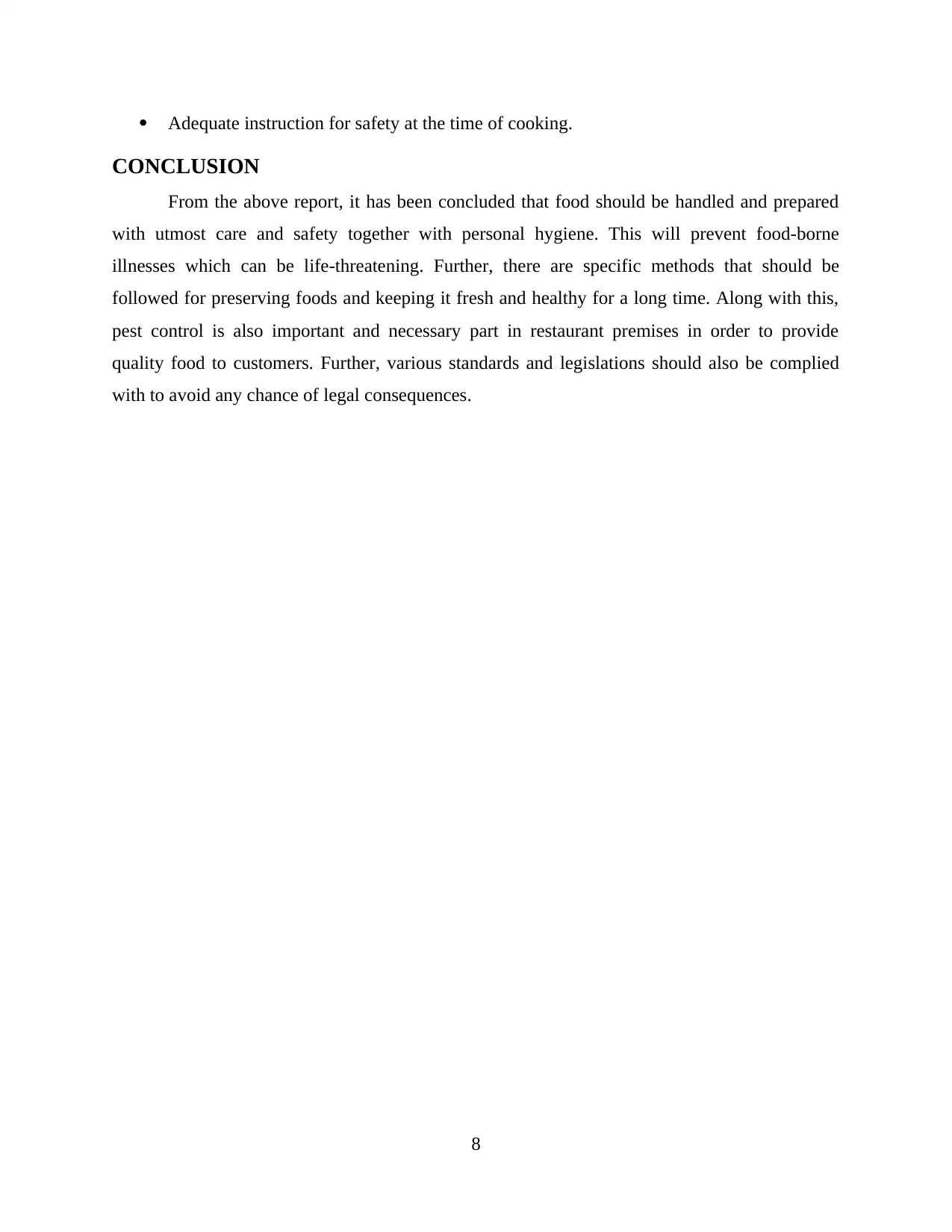
Adequate instruction for safety at the time of cooking.
CONCLUSION
From the above report, it has been concluded that food should be handled and prepared
with utmost care and safety together with personal hygiene. This will prevent food-borne
illnesses which can be life-threatening. Further, there are specific methods that should be
followed for preserving foods and keeping it fresh and healthy for a long time. Along with this,
pest control is also important and necessary part in restaurant premises in order to provide
quality food to customers. Further, various standards and legislations should also be complied
with to avoid any chance of legal consequences.
8
CONCLUSION
From the above report, it has been concluded that food should be handled and prepared
with utmost care and safety together with personal hygiene. This will prevent food-borne
illnesses which can be life-threatening. Further, there are specific methods that should be
followed for preserving foods and keeping it fresh and healthy for a long time. Along with this,
pest control is also important and necessary part in restaurant premises in order to provide
quality food to customers. Further, various standards and legislations should also be complied
with to avoid any chance of legal consequences.
8
Paraphrase This Document
Need a fresh take? Get an instant paraphrase of this document with our AI Paraphraser
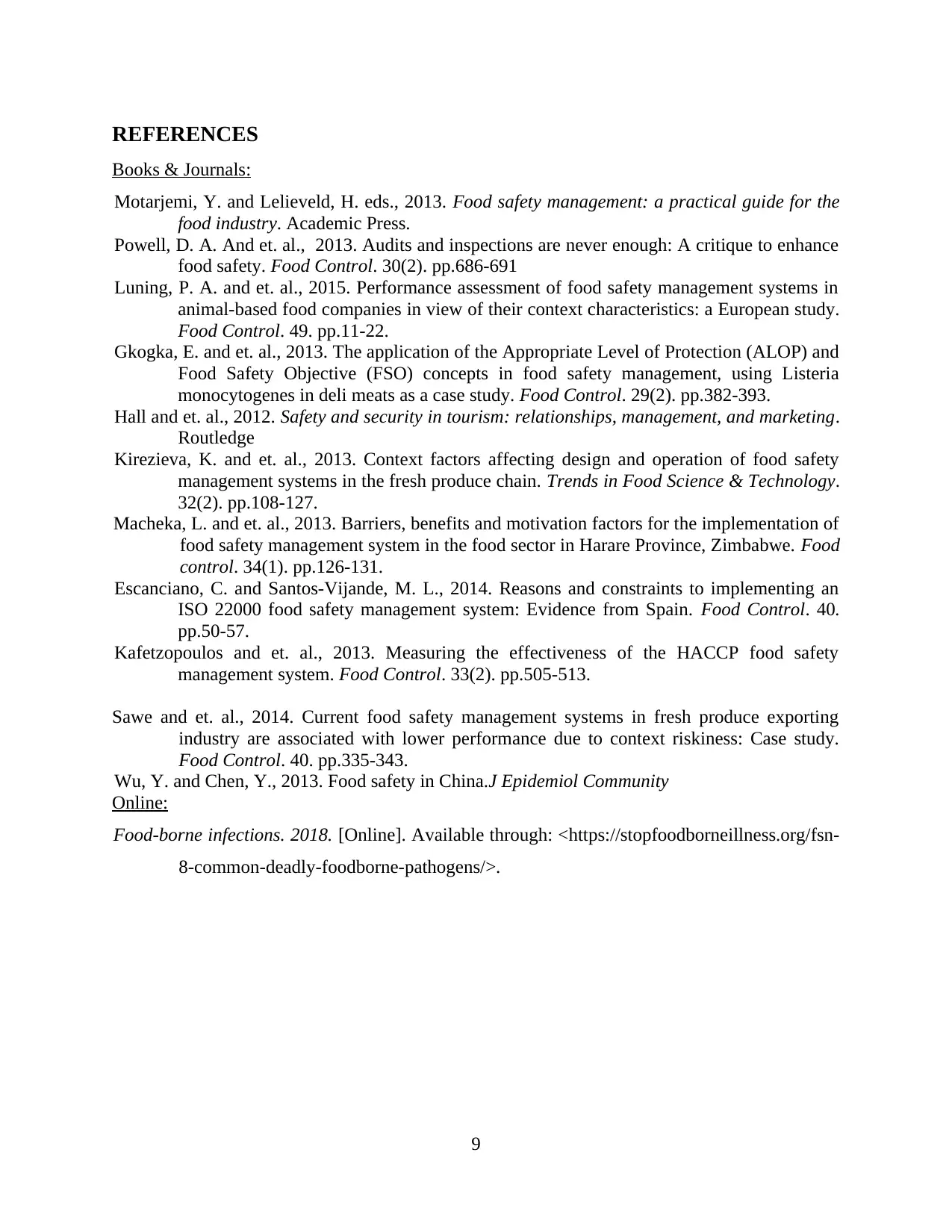
REFERENCES
Books & Journals:
Motarjemi, Y. and Lelieveld, H. eds., 2013. Food safety management: a practical guide for the
food industry. Academic Press.
Powell, D. A. And et. al., 2013. Audits and inspections are never enough: A critique to enhance
food safety. Food Control. 30(2). pp.686-691
Luning, P. A. and et. al., 2015. Performance assessment of food safety management systems in
animal-based food companies in view of their context characteristics: a European study.
Food Control. 49. pp.11-22.
Gkogka, E. and et. al., 2013. The application of the Appropriate Level of Protection (ALOP) and
Food Safety Objective (FSO) concepts in food safety management, using Listeria
monocytogenes in deli meats as a case study. Food Control. 29(2). pp.382-393.
Hall and et. al., 2012. Safety and security in tourism: relationships, management, and marketing.
Routledge
Kirezieva, K. and et. al., 2013. Context factors affecting design and operation of food safety
management systems in the fresh produce chain. Trends in Food Science & Technology.
32(2). pp.108-127.
Macheka, L. and et. al., 2013. Barriers, benefits and motivation factors for the implementation of
food safety management system in the food sector in Harare Province, Zimbabwe. Food
control. 34(1). pp.126-131.
Escanciano, C. and Santos-Vijande, M. L., 2014. Reasons and constraints to implementing an
ISO 22000 food safety management system: Evidence from Spain. Food Control. 40.
pp.50-57.
Kafetzopoulos and et. al., 2013. Measuring the effectiveness of the HACCP food safety
management system. Food Control. 33(2). pp.505-513.
Sawe and et. al., 2014. Current food safety management systems in fresh produce exporting
industry are associated with lower performance due to context riskiness: Case study.
Food Control. 40. pp.335-343.
Wu, Y. and Chen, Y., 2013. Food safety in China.J Epidemiol Community
Online:
Food-borne infections. 2018. [Online]. Available through: <https://stopfoodborneillness.org/fsn-
8-common-deadly-foodborne-pathogens/>.
9
Books & Journals:
Motarjemi, Y. and Lelieveld, H. eds., 2013. Food safety management: a practical guide for the
food industry. Academic Press.
Powell, D. A. And et. al., 2013. Audits and inspections are never enough: A critique to enhance
food safety. Food Control. 30(2). pp.686-691
Luning, P. A. and et. al., 2015. Performance assessment of food safety management systems in
animal-based food companies in view of their context characteristics: a European study.
Food Control. 49. pp.11-22.
Gkogka, E. and et. al., 2013. The application of the Appropriate Level of Protection (ALOP) and
Food Safety Objective (FSO) concepts in food safety management, using Listeria
monocytogenes in deli meats as a case study. Food Control. 29(2). pp.382-393.
Hall and et. al., 2012. Safety and security in tourism: relationships, management, and marketing.
Routledge
Kirezieva, K. and et. al., 2013. Context factors affecting design and operation of food safety
management systems in the fresh produce chain. Trends in Food Science & Technology.
32(2). pp.108-127.
Macheka, L. and et. al., 2013. Barriers, benefits and motivation factors for the implementation of
food safety management system in the food sector in Harare Province, Zimbabwe. Food
control. 34(1). pp.126-131.
Escanciano, C. and Santos-Vijande, M. L., 2014. Reasons and constraints to implementing an
ISO 22000 food safety management system: Evidence from Spain. Food Control. 40.
pp.50-57.
Kafetzopoulos and et. al., 2013. Measuring the effectiveness of the HACCP food safety
management system. Food Control. 33(2). pp.505-513.
Sawe and et. al., 2014. Current food safety management systems in fresh produce exporting
industry are associated with lower performance due to context riskiness: Case study.
Food Control. 40. pp.335-343.
Wu, Y. and Chen, Y., 2013. Food safety in China.J Epidemiol Community
Online:
Food-borne infections. 2018. [Online]. Available through: <https://stopfoodborneillness.org/fsn-
8-common-deadly-foodborne-pathogens/>.
9
1 out of 11
Related Documents
Your All-in-One AI-Powered Toolkit for Academic Success.
+13062052269
info@desklib.com
Available 24*7 on WhatsApp / Email
![[object Object]](/_next/static/media/star-bottom.7253800d.svg)
Unlock your academic potential
Copyright © 2020–2025 A2Z Services. All Rights Reserved. Developed and managed by ZUCOL.





